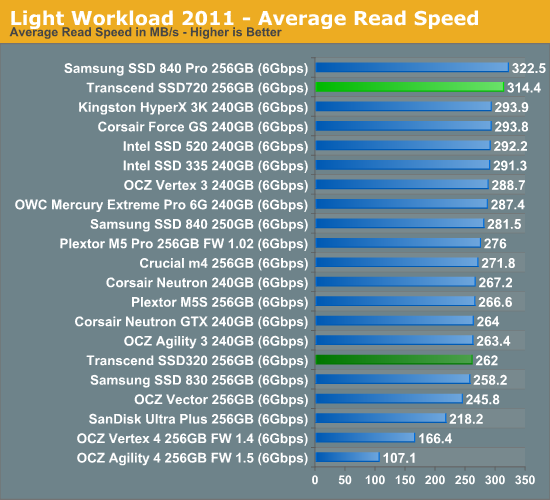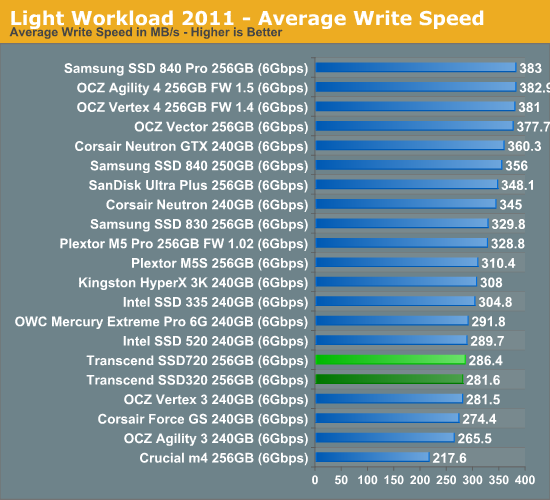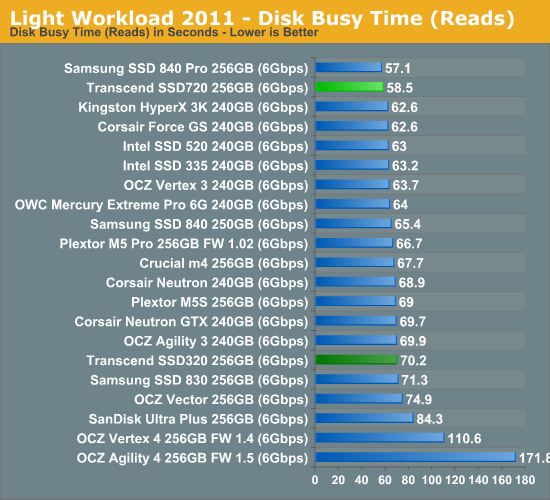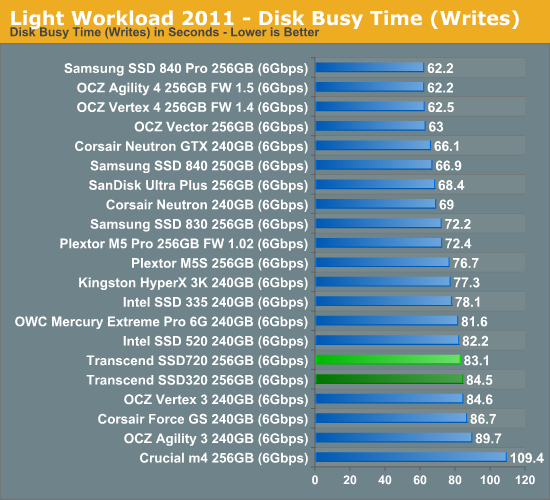Transcend SSD320 & SSD720 (256GB) Review
by Kristian Vättö on January 25, 2013 11:31 AM ESTAnandTech Storage Bench 2011—Light Workload
Our new light workload actually has more write operations than read operations. The split is as follows: 372,630 reads and 459,709 writes. The relatively close read/write ratio does better mimic a typical light workload (although even lighter workloads would be far more read centric).
The I/O breakdown is similar to the heavy workload at small IOs, however you'll notice that there are far fewer large IO transfers:
| AnandTech Storage Bench 2011—Light Workload IO Breakdown | ||||
| IO Size | % of Total | |||
| 4KB | 27% | |||
| 16KB | 8% | |||
| 32KB | 6% | |||
| 64KB | 5% | |||
















34 Comments
View All Comments
Slash3 - Saturday, January 26, 2013 - link
I picked up one of these (128GB SSD320) when they were about half of the stated market price ($75) during a holiday sale, to put in my Lenovo X230 subcompact laptop. Works great in that capacity, is leaps and bounds above the performance of the stock HDD and adds a margin of shockproofing to a laptop that sees a lot of travel time. At higher prices, it's not as clear cut. If they manage to keep the prices competitive, it's not a bad alternative for a system that needs a basic SSD.Kristian Vättö - Saturday, January 26, 2013 - link
Yup, the regular SSD 840, not the Pro.dj christian - Friday, February 1, 2013 - link
Why not the Pro version?Scour - Saturday, February 16, 2013 - link
Because the Pro is much more expensive?killerbunnies - Saturday, January 26, 2013 - link
Where is the consistency performance for the last two SSD articles?And when can we expect the Intel 520 series 240GB SSD to be included in those graphs?
Kristian Vättö - Saturday, January 26, 2013 - link
There is no point in testing performance consistency with every model. We've tested performance consistency with Intel SSD 335 before, which tells us how SandForce based drives perform. There are no dramatic differences between SandForce based drives, hence we only test consistency when dealing with more unique SSDs.http://www.anandtech.com/show/6428/corsair-neutron...
Nickel020 - Saturday, January 26, 2013 - link
I would have thought that the lower spare area would have an impact on performance consistency. Do you not think that will be the case or is the capacity set apart for RAISE not usable as spare area?Kristian Vättö - Sunday, January 27, 2013 - link
Here are a few graphs of Intel SSD 335 with 25% OP:https://dl.dropbox.com/u/7934241/25%25%20OP_1.png
https://dl.dropbox.com/u/7934241/25%25%20OP_1.png
https://dl.dropbox.com/u/7934241/25%25%20OP%20non-...
Nickel020 - Sunday, January 27, 2013 - link
Thnaks, but I don't quite get it. 25% OP is more than usual, so performance should be more consistent at best, or the same at the worst. The Transcends have less OP though, and I was wondering how you think that would affect consistency?Kristian Vättö - Sunday, January 27, 2013 - link
Oh, sorry, misunderstood your post (I thought you were asking for how more OP would affect the IO consistency on a SandForce drive).Anyway, Transcend only has RAISE disabled - the actual space for OP is the same ~7%. RAISE should not impact consistency because it's just parity data (i.e. the blocks are not empty). However, I haven't tested this so I can't say for sure. Will definitely test, though, didn't even think about it from this angle.